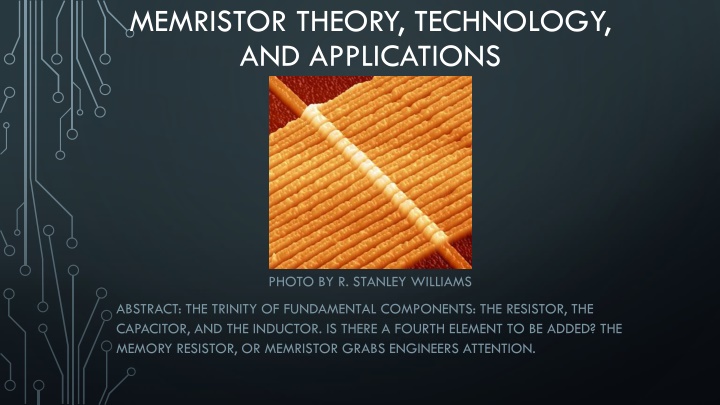
Unveiling the Memristor: Theory, Technology, and Applications
Explore the fascinating world of memristors, the fourth fundamental circuit element. Delve into the history, theory, and practical applications of memristors, including how they are made and their unique memory-retaining properties. Discover the groundbreaking research by visionaries like Leon O. Chua and R. Stanley Williams that led to the emergence of memristor technology. Unleash the potential of memristors in optimizing performance, enhancing memory capabilities, and enabling innovative applications across various fields.
Download Presentation

Please find below an Image/Link to download the presentation.
The content on the website is provided AS IS for your information and personal use only. It may not be sold, licensed, or shared on other websites without obtaining consent from the author. If you encounter any issues during the download, it is possible that the publisher has removed the file from their server.
You are allowed to download the files provided on this website for personal or commercial use, subject to the condition that they are used lawfully. All files are the property of their respective owners.
The content on the website is provided AS IS for your information and personal use only. It may not be sold, licensed, or shared on other websites without obtaining consent from the author.
E N D
Presentation Transcript
MEMRISTOR THEORY, TECHNOLOGY, AND APPLICATIONS PHOTO BY R. STANLEY WILLIAMS ABSTRACT: THE TRINITY OF FUNDAMENTAL COMPONENTS: THE RESISTOR, THE CAPACITOR, AND THE INDUCTOR. IS THERE A FOURTH ELEMENT TO BE ADDED? THE MEMORY RESISTOR, OR MEMRISTOR GRABS ENGINEERS ATTENTION.
INTRODUCTION/OUTLINE The history and theory of memristors. The rediscovery What is a memristor? How does it work? Two different ways they are made. Current research being done. Conclusion and future applications
THE PREDICTION AND THEORY (1971) The memristor was first theorized in 1971 by a man named Leon O Chua at the University of California, Berkeley. He proposed a mathematical relationship between charge and flux and set that to represent a memristor.
R. STANLEY WILLIAMS In 2008, HP senior Stanley Williams and his team discovered that there molecular device they were researching was acting fairly like Chua s description of the memristor. Noticed a similar relationship between magnetic flux and charge that a resistor gives between voltage and current.
THE MEMORY RESISTOR A two-terminal element Just like its name, the memristor carries memory of its past. When the voltage is turned off, the memristor remembers how much voltage was applied before it was turned off and the duration. This effect cannot be duplicated by any circuit combination of the three fundamental components. Making the memristor the fourth fundamental circuit element. It can provide dynamical-negative resistance.
APPLYING A SINE WAVE AND I-V CURVE CHARACTERISTICS.
SOME FACTS ABOUT MEMRISTORS Achievable through different physical mechanisms Phase change, electrostatic, redox Many applications enabled by orthogonal properties Optimizers, high endurance + incremental Learners, incremental + low decay Memory, fast switching + low decay Oscillators, high endurance
HOW CURRENT MEMRISTORS ARE MADE In 2008, Stanley Williams found an ideal memristror in titanium dioxide Like silicon titanium dioxide is a semiconductor. At its pure state titanium oxide is highly resistive. It can then be doped with other elements to make it very conductive. Knowm s memristor devices use Tin (Sn) or Chromium (Cr) or Tungsten (W) in the chalcogenide layer. Can be fabricated at <500 degrees C using industry-standard unit-process steps.
KNOWMS MEMRISTOR 2016, Knowm s Inc announced 3 new variations of memristors targeting different neuromorphic applications. While still in early design the analog applications have existing current leakage causing stored values to degrade overtime.
KNOWMS MEMRISTOR (CONT.) The first to develop and make it commercially available for research purposes. 3 types, they all have same basic material structure but differ in the dopant layer. GeSeW (the W device) GeSeSn (the Sn device) GeSeCr (the Cr device)
CONCLUSION, AND FUTURE APPLICATIONS There is current research being done on the memory resistors in order to perfect the memristor so that it can be applied to future electronics. You can now purchase and do personal research on ways you can applicate memristors. FUTUTRE APPLICATIONS Denser nonvolatile memories, oscillators New universal logic gates Brain like computers Post-Moores s-Law IC s Analog Design, and computing Artificial Intellagence
REFERENCES Korczynski, Ed, Dr. "Memristor." Semiconductor Manufacturing & Design Community. N.p., 22 Jan. 2016. Web. 13 Apr. 2017. Revolvy, LLC. ""Memristor" on Revolvy.com." All Revolvy Quizzes. N.p., n.d. Web. 18 Apr. 2017. <https://www.revolvy.com/topic/Memristor>. Adee, Sally. "The Mysterious Memristor." IEEE Spectrum: Technology, Engineering, and Science News. IEEE Spectrum, 01 May 2008. Web. 18 Apr. 2017. http://spectrum.ieee.org/semiconductors/design/the-mysterious-memristor "Memristors." Knowm.org. N.p., n.d. Web. 18 Apr. 2017. <http://knowm.org/memristors/>. "The Story of My Memristor Kris Campbell." Knowm.org. N.p., n.d. Web. 18 Apr. 2017. <http://knowm.org/the-story-of-my-memristor-kris-campbell/>.
5 KEY TOPICS 1.What is a Memristor? How does it work? 2. Memristors have a relationship through magnetic charge and flux. 3. Orthogonal properties and applications. 4. The doping elements of current Memristors. 5. I-V characteristics when a sine wave is applied.
